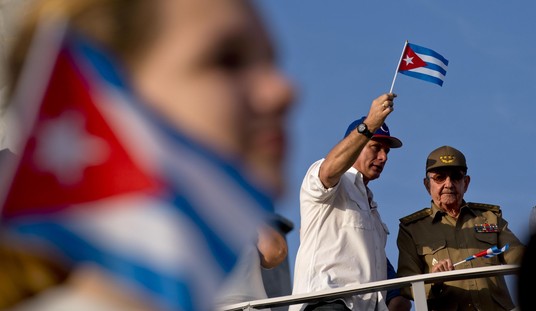It’s all fun and games until someone starts imposing price caps, it seems. Catherine Rampell has spent months warning and rebuking Democrats for their attempts to demagogue on inflation by chalking it up to “corporate greed,” a nonsensical claim given that corporations didn’t just start operating in March 2021.
It’s one thing to use it as demagoguery, which is bad enough. It’s quite another to actually swallow this absurdity and believe it, Rampell writes at the Washington Post today. Too many Democrats have jumped feet-first into the conspiracy-theory pool, buying into the “greedflation” myth:
For example, a bill introduced on Thursday by Democratic Sens. Elizabeth Warren (Mass.) and Tammy Baldwin (Wis.) and Rep. Jan Schakowsky (D-Ill.) bans “price-gouging,” which it defines as “unconscionably excessive” pricing.
What counts as an “unconscionably excessive” price, you ask? TBD, but it’s definitely going to be illegal.
The problem with this narrative is that it’s just a pejorative tautology. Yes, prices are going up because companies are raising prices. Okay. This is the economic equivalent of saying “It’s raining because water is falling from the sky.” Well, why?
Rampell answers her own question:
Demand is strong, thanks to pandemic-forced savings plus expansionary government policies (stimulus payments, low interest rates, etc.). Meanwhile, supply remains constrained by covid-related disruptions, labor shortages, other unfortunate shocks. Companies can’t ramp up production quickly enough to procure all the stuff that consumers want to buy, whether that “stuff” is oil, furniture or eggs.
Consumers still want to buy all this stuff, though, and Americans overall have an unusually high amount of cash on hand. So they are willing to pay more. That pushes prices up.
That is a simple and eloquent explanation of demand-side inflation. It is, in fact, the result of badly designed government intervention in the form of too much direct stimulus while continuing to constrict supply. The term “COVID-related disruptions” covers a lot of ground. Certainly the disease itself disrupted workforces, but not as much as government interventions did in attempts to prevent community transmission that largely happened anyway. The Biden administration spent much of last year pursuing vaccine and mask mandates for workplace access that were not only unconstitutional but also deeply counterproductive in the middle of a supply-chain crisis.
But what about another aspect of supply-side inflation? Gas prices have shot through the roof over the last several months, and it’s not as if the oil companies had ever been accused of a lack of avarice before Joe Biden took office. The excessive rate of increase in gas prices began long before Vladimir Putin even began positioning troops for his invasion of Ukraine.
Here’s the EIA data on average gas prices per gallon, all formulations, over the last 30 years. Take a good look at where the current spike began:

The latest spike isn’t the only one worth noting, either. The brief period at the end of the George W. Bush administration where the average price went well over $3 a gallon came after Hurricane Katrina knocked out a good portion of the nation’s refining capacity in the Gulf of Mexico. The next sustained period, as well as our present period, came when Obama and Biden administration policies restricted supply by imposing serious regulatory burdens on exploration, extraction, and refining. Both administrations made those supply-dampening burdens an explicit feature of their policy portfolios. Obama and Biden both pledged to reduce consumption of fossil fuels and calculated higher prices as part of the disincentives that would force consumers to choose other energy forms.
And the easiest way to demonstrate causation on this issue is to show the historicak data on CPI and PPI. That’s especially on point given that energy prices act as a force multiplier on inflation in both, and perhaps on CPI in particular, as gas prices impact the distribution chain at several stages before final sales. Here’s the CPI data on gasoline:

Here’s CPI overall over 30 years, courtesy of the New York Times:

And here’s some historical data on the producer price index:

What do all of these have in common? They all show massive upward spikes in what had been stable levels of inflation before Biden took office. That leaves us with three possible explanations: corporate greed only got invented in February 2021, Joe Biden is exceptionally incompetent at containing corporate greed (and Donald Trump was a master at it), or Democrats are full of effluvium and/or ignorance.
I know which way I’m betting.
Rampell points out that reversing this policy choice would go a long way toward solving inflation now:
The solution to the broader increase in prices, then, is ramping up supply (e.g., getting more workers in the labor force, removing trade barriers, encouraging oil-drilling); and/or, tamping down demand (e.g., raising interest rates).
It would, but Biden and his team aren’t all that interested in tamping down inflation per se. Higher prices were always a feature of Biden’s climate-change agenda, although I’d bet that even he didn’t realize just how much of a political problem it would create. Democrats want to use this as an excuse to grab more power to create a centrally controlled economy with themselves as the star chamber running it. That’s why Nancy Pelosi has seized the opportunity to impose price controls on gasoline, and why the progressives in the Senate are proposing price controls on everything else as well.
Greedflation is a conspiracy theory, all right, but one with a purpose.








